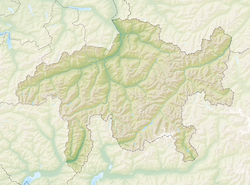Lohn (Romansh: Lon) is a former municipality in the Viamala Region in the Swiss canton of Graubünden. On 1 January 2021 the former municipalities of Casti-Wergenstein, Donat, Lohn and Mathon merged to form the new municipality of Muntogna da Schons.[3]
Lohn | |
|---|---|
 | |
| Coordinates: 46°39′N 9°25′E / 46.650°N 9.417°E | |
| Country | Switzerland |
| Canton | Graubünden |
| District | Viamala |
| Area | |
• Total | 8.17 km2 (3.15 sq mi) |
| Elevation | 1,585 m (5,200 ft) |
| Population (31 December 2018)[2] | |
• Total | 46 |
| • Density | 5.6/km2 (15/sq mi) |
| Time zone | UTC+01:00 (Central European Time) |
| • Summer (DST) | UTC+02:00 (Central European Summer Time) |
| Postal code(s) | 7433 |
| SFOS number | 3707 |
| ISO 3166 code | CH-GR |
| Surrounded by | Donat, Mathon, Rongellen, Thusis, Tschappina, Urmein, Zillis-Reischen |
| Website | www SFSO statistics |
History
editLohn is first mentioned in mid-12th Century as Laune and Lune. In 1219 it was mentioned as de Laone.[4]
Geography
editLohn had an area, as of 2006[update], of 8.1 km2 (3.1 sq mi). Of this area, 56.5% is used for agricultural purposes, while 35% is forested. Of the rest of the land, 1.5% is settled (buildings or roads) and the remainder (7%) is non-productive (rivers, glaciers or mountains).[5]
Before 2017, the former municipality was located in the Schams sub-district, of the Hinterrhein district, after 2017 it was part of the Viamala Region.[6] It is a haufendorf (an irregular, unplanned and quite closely packed village, built around a central square) located at an elevation of 1,582 m (5,190 ft) on the upper Schamserberg.
Demographics
editLohn had a population (as of 2019) of 52. Over the last 10 years the population has decreased at a rate of -10.7%.[5]
As of 2000[update], the gender distribution of the population was 44.0% male and 56.0% female.[7] The age distribution, as of 2000[update], in Lohn is; 5 people or 10.0% of the population are between 0 and 9 years old. 9 people or 18.0% are 10 to 14, and people or 0.0% are 15 to 19. Of the adult population, 1 person or 2.0% of the population is between 20 and 29 years old. 5 people or 10.0% are 30 to 39, 9 people or 18.0% are 40 to 49, and 1 person or 2.0% is 50 to 59. The senior population distribution is 10 people or 20.0% of the population are between 60 and 69 years old, 10 people or 20.0% are 70 to 79.[8]
In the 2007 federal election the most popular party was the SVP which received 45.1% of the vote. The next three most popular parties were the FDP (28.9%), the SPS (21.8%) and the CVP (4.2%).[5]
In Lohn about 82.4% of the population (between age 25-64) have completed either non-mandatory upper secondary education or additional higher education (either university or a Fachhochschule).[5]
Lohn has an unemployment rate of 0%. As of 2005[update], there were 23 people employed in the primary economic sector and about 7 businesses involved in this sector.[5]
The historical population is given in the following graph:[4]

Languages
editMost of the population (as of 2000[update]) speaks Rhaeto-Romance (52.0%) and the rest speak German (48.0%).[5]
| Languages | Census 1980 | Census 1990 | Census 2000 | |||
|---|---|---|---|---|---|---|
| Number | Percent | Number | Percent | Number | Percent | |
| German | 0 | 0.00% | 18 | 37.50% | 24 | 48.00% |
| Romanish | 36 | 100% | 30 | 62.50% | 26 | 52.00% |
| Population | 36 | 100% | 48 | 100% | 50 | 100% |
References
edit- ^ a b "Arealstatistik Standard - Gemeinden nach 4 Hauptbereichen". Federal Statistical Office. Retrieved 13 January 2019.
- ^ "Ständige Wohnbevölkerung nach Staatsangehörigkeitskategorie Geschlecht und Gemeinde; Provisorische Jahresergebnisse; 2018". Federal Statistical Office. 9 April 2019. Retrieved 11 April 2019.
- ^ "Applikation der Schweizer Gemeinden". bfs.admin.ch. Swiss Federal Statistical Office. 2021. Retrieved 5 January 2021.
- ^ a b Lohn in German, French and Italian in the online Historical Dictionary of Switzerland.
- ^ a b c d e f Swiss Federal Statistical Office Archived 2016-01-05 at the Wayback Machine accessed 7 October 2009
- ^ Swiss Federal Statistical Office - Amtliches Gemeindeverzeichnis der Schweiz - Mutationsmeldungen 2016 accessed 16 February 2017
- ^ Graubunden in Numbers Archived 2009-09-24 at the Wayback Machine (in German) accessed 21 September 2009
- ^ Graubunden Population Statistics Archived 2009-08-27 at the Wayback Machine (in German) accessed 21 September 2009



